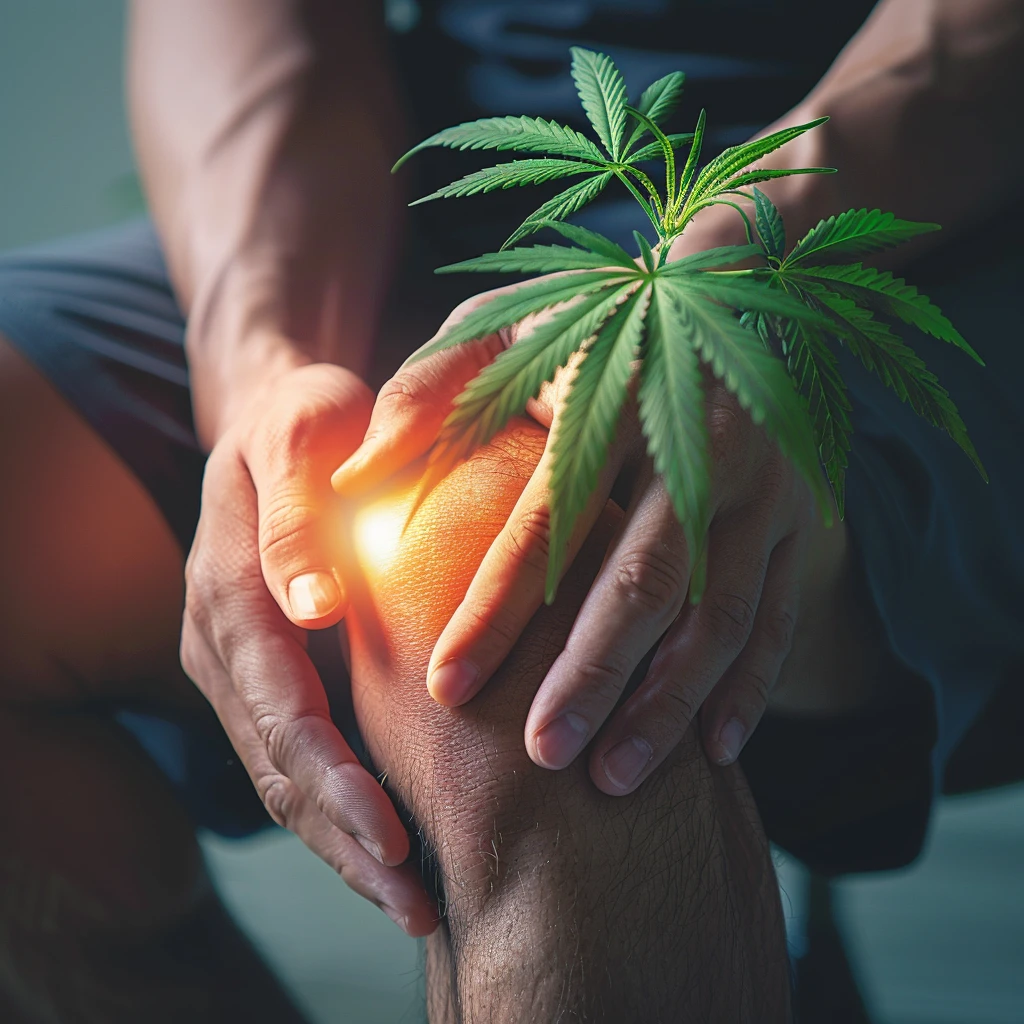In the sprawling landscape of chronic conditions, arthritis and joint pain stand as colossal challenges affecting millions worldwide. These debilitating conditions not only impair physical mobility but also diminish the quality of life, making everyday tasks daunting and painful. Amidst an array of conventional treatments ranging from over-the-counter pain relievers to more invasive options like surgery, medical cannabis emerges as a soothing balm, offering a natural and holistic approach to pain relief and inflammation reduction. This in-depth exploration delves into the efficacy of cannabis in alleviating arthritis symptoms, shedding light on its mechanisms, benefits, and the potential it holds for those seeking relief from relentless joint pain.


Table of Contents
ToggleUnderstanding Arthritis and Joint Pain
Arthritis encompasses a range of conditions characterized by inflammation and pain in the joints. The most common types, osteoarthritis (OA) and rheumatoid arthritis (RA), affect different aspects of the joints but both lead to chronic pain and mobility limitations. Osteoarthritis results from wear and tear, leading to the degradation of joint cartilage, while rheumatoid arthritis is an autoimmune condition that causes the immune system to attack the joint linings.
The Limitations of Traditional Treatments
Traditional treatment modalities for arthritis often involve nonsteroidal anti-inflammatory drugs (NSAIDs), corticosteroids, and disease-modifying antirheumatic drugs (DMARDs), each with potential side effects ranging from gastrointestinal distress to increased risk of infections. For many patients, these treatments offer incomplete relief, driving the search for alternative and complementary therapies that can enhance quality of life with fewer undesirable effects.


The Role of Cannabis in Arthritis and Joint Pain Management
Cannabis has been used for centuries to treat a variety of pain-related ailments, with modern science beginning to unravel the reasons behind its pain-relieving properties. Cannabinoids, the active compounds found in cannabis, interact with the body’s endocannabinoid system (ECS), which plays a crucial role in regulating pain and inflammation.
Cannabinoids: THC and CBD
The two most studied cannabinoids, THC (tetrahydrocannabinol) and CBD (cannabidiol), offer distinct benefits for arthritis sufferers. THC is known for its potent analgesic and anti-inflammatory properties but is also psychoactive, which can be a deterrent for some users. CBD, on the other hand, provides comparable anti-inflammatory effects without the psychoactive high, making it an appealing option for those who wish to avoid the mental effects of cannabis.
Modulating Pain and Inflammation
Cannabinoids modulate pain and inflammation primarily through their interaction with the cannabinoid receptors CB1 and CB2 found throughout the body and immune system. By activating these receptors, cannabinoids can help reduce the production of cytokines and other inflammatory compounds in the joints, thereby alleviating pain and swelling associated with arthritis.


Integrating Cannabis into Arthritis Treatment
Incorporating cannabis into an arthritis treatment regimen should be done thoughtfully and under medical supervision to ensure optimal results and minimize risks.
Personalized Cannabis Therapy
Due to the variability in how individuals respond to cannabis, personalized treatment plans are crucial. Factors such as the specific type of arthritis, severity of symptoms, and personal health conditions should guide the choice of cannabinoid profiles (THC vs. CBD), dosages, and methods of administration.
Delivery Methods
Cannabis can be consumed in various forms, including tinctures, topicals, edibles, and oils. Each method offers different benefits; for example, topicals can provide targeted relief from joint pain without systemic effects, while tinctures and oils allow for easier dose management and longer-lasting relief.
Challenges and Considerations
While promising, the use of cannabis in arthritis treatment is not without challenges. Legal restrictions, variability in cannabis quality and potency, and a lack of standardized dosing guidelines can complicate its use. Additionally, the potential for interactions with existing medications should be carefully considered.
Looking Forward: Research and Advocacy
As interest in cannabis for medical use grows, so too does the body of research exploring its potential. Ongoing studies and clinical trials are essential for establishing standardized treatment protocols and expanding legal access. Advocacy plays a critical role in this process, as both patients and healthcare providers seek to redefine the landscape of arthritis treatment.
In conclusion, medical cannabis offers a promising complementary therapy for arthritis and joint pain, capable of reducing pain and inflammation with fewer side effects than many traditional medications. As we continue to explore and understand the full capabilities of cannabis, its role in enhancing the lives of those with arthritis becomes increasingly clear, marking a new era of hope and healing in the management of chronic pain.
FAQ: Medical Uses of Cannabis for Arthritis and Joint Pain
How does cannabis help alleviate arthritis and joint pain?
Cannabis helps alleviate arthritis and joint pain primarily through its active compounds, THC and CBD, which interact with the body’s endocannabinoid system (ECS). This interaction helps reduce inflammation and pain by modulating immune responses and pain perception pathways in the body.
Can cannabis cure arthritis?
No, cannabis does not cure arthritis. It is used to manage symptoms associated with arthritis, such as pain and inflammation, which can improve quality of life but does not alter the disease’s progression.
Is there a difference between using THC and CBD for arthritis pain?
Yes, there are differences. THC is known for its potent pain-relieving properties and can also reduce inflammation, but it has psychoactive effects that can alter mood and perception. CBD, on the other hand, does not produce psychoactive effects and is also effective in reducing inflammation and pain, making it a suitable option for those who wish to avoid the “high” associated with THC.
What are the best ways to use cannabis for arthritis?
The best method can vary based on individual preferences and specific symptoms. Topical applications like creams and salves can be applied directly to the joints for localized relief without psychoactive effects. Oral forms such as tinctures, oils, and edibles offer systemic relief and longer-lasting effects but may include psychoactive experiences if they contain THC.
Are there any side effects of using cannabis for arthritis?
Potential side effects of using cannabis, especially products containing THC, include dizziness, dry mouth, short-term memory loss, and in some cases, anxiety. CBD is generally well-tolerated, with fewer side effects, though it can interact with other medications.
How do I start using cannabis for arthritis?
Starting cannabis for arthritis should be done under the guidance of a healthcare provider knowledgeable in cannabis use and arthritis management. This will ensure proper dosing, the selection of appropriate cannabinoid profiles, and monitoring of any interactions with other treatments.
Can I use cannabis with my current arthritis medications?
Cannabis can often be used alongside other arthritis medications, but it’s essential to consult with a healthcare provider due to potential interactions. For example, cannabis can alter the effectiveness of some drugs or exacerbate their side effects.
Is medical cannabis legal for arthritis treatment?
The legality of medical cannabis varies by location. In regions where it is legal, you typically need a prescription or a medical cannabis card to obtain and use it legally. Always check local regulations and consult with healthcare provi
What should I do if I experience side effects from cannabis?
If you experience side effects from using cannabis, it is important to consult your healthcare provider immediately. They may adjust your dosage, change the formulation, or advise on alternative treatment options.
How quickly can I expect to see results from using cannabis for arthritis pain?
The onset of effects depends on the method of administration. Inhalation provides quick relief, usually within minutes, while topicals might take longer to be effective but focus relief on the area of application. Oral ingestion can take one to two hours to take effect but usually provides longer-lasting relief.
These FAQs aim to provide a comprehensive overview of using medical cannabis for arthritis and joint pain, helping individuals make informed decisions about incorporating cannabis into their treatment strategy.
Kannabu's Online Cannabis Educational Resources
Read Educational Online Guides and Articles to Learn About Cannabis
- Navigating the Green Path: CBD vs. THC in Medical Treatment
- The Aromatic Architects of Healing: The Role of Terpenes in Medical Cannabis
- Navigating the Green Frontier: Clinical Trials on Cannabis and Its Effects
- Charting the Green Path: Cannabis Dosing Guidelines for Medical Use
- The Endocannabinoid System: Nature’s Balancing Act in Human Health
- A Green Horizon: Cannabis as an Alternative to Opioids
- Navigating the Mind’s Garden: Cannabis and Mental Health Treatment
- Unlocking the Green Code: Exploring the Genetic Diversity and Pharmacological Promise of Cannabis
- Weaving Green into Gold: The Integration of Medical Cannabis into Traditional Medicine
- The Therapeutic Promise of Medical Cannabis: Exploring the Spectrum of Cannabinoids
- From Young to Old: The Compassionate Embrace of Medical Cannabis in Pediatric and Geriatric Care
- Green vs. Traditional: Navigating the Crossroads of Medical Cannabis and Conventional Therapies
- Beyond the Pain: The Comparative Effectiveness of Cannabis in Chronic Pain Management
- Unlocking Cannabis’s Secrets: The Journey Through Cannabinoid Pharmacokinetics and Pharmacodynamics
- Green Paws: Navigating the Frontier of Medical Cannabis in Veterinary Care
- Unlocking Relief: The Transformative Role of Medical Cannabis in Pain Management
- Harnessing Harmony: Medical Cannabis and the Battle Against Autoimmune Disorders
- Embracing the Night: How Medical Cannabis Transforms Sleep Management
- Turning the Tide: Cannabis as a Catalyst for Relief and Recovery in Nausea and Appetite Stimulation
- Illuminating the Neural Pathways: The Transformative Role of Medical Cannabis in Neurological Conditions
- Harnessing Harmony: Medical Cannabis and the Battle Against Autoimmune Disorders
- A Clearer View: Medical Cannabis in the Treatment of Glaucoma
- Breaking Boundaries: Cannabis and the New Frontier in Epilepsy and Seizure Control
- Revolutionizing Relief: Medical Cannabis in Cancer Symptom Management
- Navigating the Storm: Cannabis as a Beacon of Hope in Multiple Sclerosis Treatment
- Cannabis: A Natural Respite for Arthritis and Joint Pain
- Healing from Within: The Role of Medical Cannabis in Treating Gastrointestinal Disorders
- Healing Invisible Wounds: Cannabis in PTSD and Trauma Treatment
- Balancing the Mind: The Potential of Medical Cannabis in Bipolar Disorder and Mood Stabilization
- Illuminating the Mind: Cannabis in the Treatment of Alzheimer’s and Neurodegenerative Diseases

